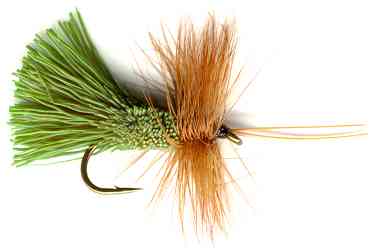Goddard's Green Caddis (G & H Sedge) Fly
Summer long horn female caddis often drift long distances on the water surface because they are exhausted after laying eggs, much to the enjoyment of slow-sipping trout who relish in feeding on such easy targets

GODDARD'S CADDIS FLY PATTERNS. Hook size 10 12 14 16 18 - $US each - Great for rough water
A number of Caddis adults have green bodies such as the Green Apple Caddis and the McKenzie Caddis, both as larvae, emergers and as adults. This is the colour that is visible to the trout looking upward. The green Goddard’s Caddis imitates the shape of the caddis and provides the correct body colour. The hackle near the hook eye imitates the insect’s legs standing on the surface film. When caddis hatches are seasonally prolonged due to good weather or the hatch is particularly dense, trout can become very selective in what they eat. They will just select drifting adult caddis as they are an easy food source. This is very similar to the behaviour they exhibit during large mayfly hatches. Instead of expending energy hunting for emergers in swift riffles and runs, these trout take the lazy approach by congregating in locations where the current brings drifting adult caddis to them. Look for eddies, pool tailouts and bank glides. That is where you will find them lurking waiting for their food to be delivered too them. They prefer to wait in areas of calmer water so they do not have to fight against the current to stay in position. Look for creases, these are lines in the water where faster water meets slower water. These can form behind rocks and bridge supports. The trout wait in the lee of the obstruction and just move into the faster water to grab a passing meal.

This is fly fisherman John Goddard designer of the Goddard's Caddis (G and H Sedge) with a brown trout
You will also find trout waiting in the shadow of an over hanging tree or shrub. Some small female caddis species will spend time waiting for their fertilised eggs to be ready to lay, sitting on leaves and branches. At the right time they just drop to the water surface to lay their eggs. These locations can provide challenging casting and hook setting situations but that is the fun of this sport. If it was easy what would be the enjoyment. Refined end of line tackle and tactics come into play when fishing flat-water small caddis hatches. Use finer tippets thinning to 6X or even 7X. Use down-and-across slackline drifts, rather than upstream casts. I find these work better as the fly is seen first by the lurking trout rather than the leader. Low quick casts work better than high slow ones which risk the trout spotting seeing your line in the air. Don’t be fooled. Fish are observant about what is moving above them. Their life depends on them spotting a kingfisher, seagull or sea eagle. They have a fright-flight instinct when they see something move above them. Always make false casts off to the side. Water clarity and hatch density are factors in what you can get away with. In heavy hatch conditions the trout are punch-drunk in a feeding frenzy. They want to eat as much food as they can before this bounty disappears. They become a little bit more reckless.

On popular rivers with heavy fishing pressure trout are more wary and you have to be more slow and careful on your approach and tactics so as not to spook the trout. You have to adapt your fishing method to the trout’s requirements. I have found that many of the biggest fish in the river are bank huggers. If up-and-over casts spook these caddis sippers, then I have found that casting down and across with an exaggerated reach cast can be the answer. You can do this by carefully wading into a slightly upstream mid-river position. Fishing tiny sized realistic caddis flies can be a problem to see. An answer to this problem is to fish two tiny imitative hook size 18 Goddard Caddis patterns tied onto the hook bend of a larger more visible pattern.
CUSTOMER'S COMMENT
This is the fly I use to imitate the green McKenzie
Green Caddis. I think its big Latin name is Arctospsyche grandis. It emerges around mid may and into mid June once the water temperature has reached around 52°f. I find that happens between 4pm and 7pm near me
when I fish the Willamette River and McKenzie River in Oregon. They spend
two years in their larval form. They do not make a case to live in. They are
aggressive eaters with a strong mouth and prowl the river bottom looking for
food. When dislodges they then become available to trout for food. - Victor
Peterson, Oregon, USA
LINKEDIN COMMENT
Apple Caddis adults have a very light colored wing, and a apple green body color. They are related to the Grannom Caddis but are different in color. I find that the Apple Caddis tends to hatch much nearer the shore unlike its cousin that seems to hatch anywhere. I use the Green Goddard's caddis as an Apple Caddis imitation and let it drift down the shore line and river bank edge. Mike King, USA


Goddard's fishing books

